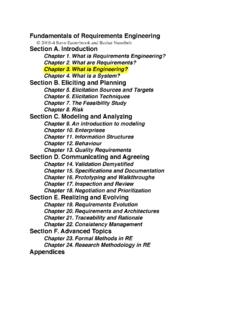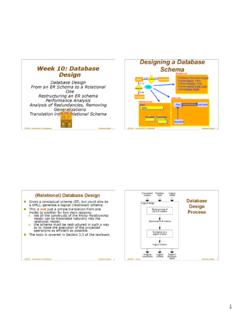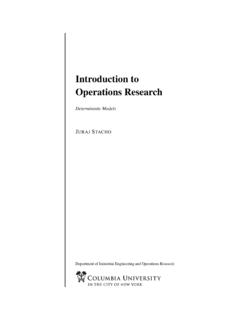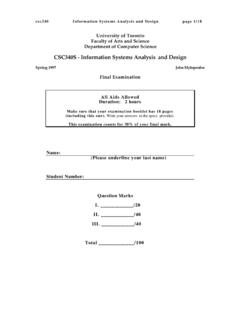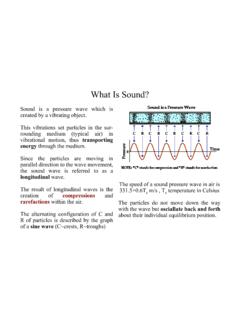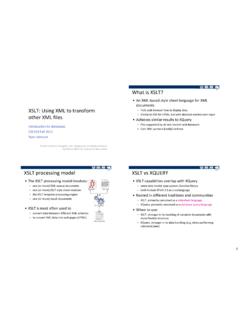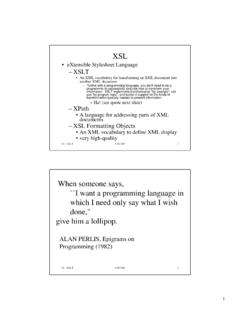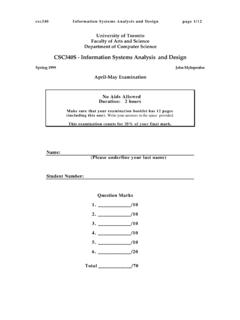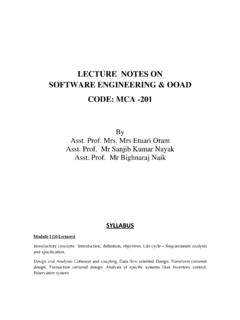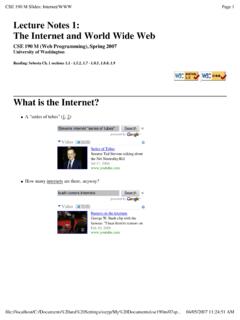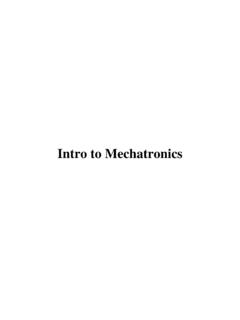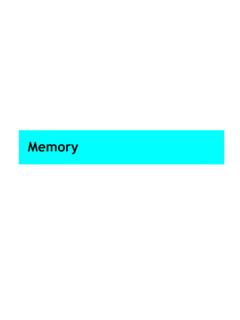Transcription of Lecture 2 Software Re-engineering - University of Toronto
1 Spring 2005 ECE450H1 SSoftware engineering IILecture 2 Software Re-engineeringSome material is based on the CSER projects at U of TCovers almost all concepts of the courseDetail explanations to come ..Copyright Yijun Yu, 2005 Spring 2005 ECE450H1 SSoftware engineering IILast Lecture ..General Information Instructor: Yijun Office: BA7200 (Bahen Center, 7thfloor), 946-8530 Office hours: Wed 5pm 6pm, Fri 2pm-3pm TA: Alexia Merchant Class homepage: ~yijun/ece450hSpring 2005 ECE450H1 SSoftware engineering IIMarking Scheme adjusted No midterm Final Exam 50% (Exam week) Course Project 50% Assignment 1 (15%): Feb 11 Assignment 2 (15%): Feb 25 Assignment 3 (20%): April 8 Spring 2005 ECE450H1 SSoftware engineering IIOur Course Project This is a brand-new Software reengineering project, emphasizing on reusing, restructuring, refactoring large-scale Software systems, and team work !
2 A1: Understanding the architecture of a legacy system (OpenOME, OmniEditor) (15%) A2: Design OmniGraphEditor web service (15%) A3: Reengineering OpenOME to use OmniGraphEditor web service of other teams (20%) Tutorials will cover detailed approaches and tools to help you with the projectSpring 2005 ECE450H1 SSoftware engineering IIToday ..1. Review SE process2. Discuss Reengineering Concepts3. Go over some case studies, a road map to our lectures and tutorials:VIM: componentization, reveal architecturesosCommerce: aspect elicitation, reveal requirementsSquirrelMail: goal elicitation from refactored code4. Your exercise is to use the learnt knowledge to study two other legacy Software systems:OpenOMEand OmniEditor5. SummarySpring 2005 ECE450H1 SSoftware engineering engineering ProcessThe Waterfall process modelSpring 2005 ECE450H1 SSoftware engineering II1.
3 Software engineering ProcessRapid Prototyping processSpring 2005 ECE450H1 SSoftware engineering II1. Software engineering ProcessSpiral (incremental) processSpring 2005 ECE450H1 SSoftware engineering II2. Reengineering concepts Why Software Reengineering? Legacy Software are increasing ( Software vs. Hardware) New technology appearing (Moore s law) Successful ratio of projects increasing (IBM internal history) Companies are more competing (now we have the open-source movement and free- Software foundation) Quality attributes are demanding (That s the selling point) People are changing (developers joining and leaving, customers are changing) Software maintenance are pressing(Largest cost in Software development lifecycle >60%)Spring 2005 ECE450H1 SSoftware engineering II2.
4 Reengineering conceptsWhat is Software reengineering?To a large extent, it involves maintenance activities: Understanding (predictive) Repairing (corrective) Improving (perfective) Evolving (adaptive) Related topics Quality-driven Software engineering (-ilities, quality attributes) Requirements engineering (goals, non-functional requirements) Software architectures (architectural views: components, statecharts, features, ..) Model-driven development (MOF, UML, EMF) Design patterns (structural, behavioural) Software refactoring (the code smells) Performance tuning (trade-offs, multi-criteria optimizations) Paradigms: Object-oriented, Goal-oriented, Agent-oriented, 2005 ECE450H1 SSoftware engineering II2. Reengineering conceptsThe Horseshoe modelSpring 2005 ECE450H1 SSoftware engineering IIThe Reengineering HorseshoeREQUIREMENTSI ntentionsArchitecturesFunctionsSource CODESTATECHARTSGOAL MODELR everse engineeringGOAL MODELSOAWeb servicescustomizablearchitecturecomponen tsForward engineeringSpring 2005 ECE450H1 SSoftware engineering IIReading assignments on Software architectures Previous Lecture note for ECE450H1S: What is Software architecture?
5 How to represent it? D. Penny. Introduction to Software architecture : ~chechik/courses00/ece450/ M. Chechnik. ADL and Darwin . ~chechik/courses00/ece450/ 2005 ECE450H1 SSoftware engineering IIFurther readings Martin Fowler. The Refactoringhomepage : CMU SEI: Software architecture . KMLab. On goal oriented Software engineering . 2005 ECE450H1 SSoftware engineering IICase Study I. VIM VIM stands for Vi- Are you a VIMer? Current version Bram Moolenaar Developed in C 172 KLOCS pring 2005 ECE450H1 SSoftware engineering IIUnderstanding the architecture of VIM Lee s initial VIM architectureSpring 2005 ECE450H1 SSoftware engineering II Vim Tran et al. Architectural Repair of Open Source Software , IWPC 2005 ECE450H1 SSoftware engineering IIG.
6 Murphy, et al. Software Reflexion Models: Bridging the gap between design and implementation , IEEE Trans. On Software engineering 27(4):364-380, 2001. Reflexion model (jRMTool) High-level model (HLM) multi-graph Source model (SM) multi-graph (source code or trace) Mapping from SM to HLM is defined by regular expressions Identify three kinds of edges: Convergence Divergence AbsenceSpring 2005 ECE450H1 SSoftware engineering IIH. Dayani-Fard, Y. Yu, J. Mylopoulos, P. Andritsos. Improving the build architecture of legacy C/C++ Software systems , Fundamental Approaches to Software engineering , April 2005. to appear ~yijun/literature/ VIM 2005 ECE450H1 SSoftware engineering IIRestructuring headers Components provides and uses interfaces In C/C++, such as VIM, interfaces are written in Headers Abstraction and information hiding is a good principle in SE, thus we should do the componentization.
7 Large-cohesion and Low coupling is the modularity principle of SE The inclusion of the headers may violate this principle Too much entities included leads to redundancies, and also False dependencies It is an advanced topic to show how to restructure the program to remove all false dependencies And also componentize the program to minimize the number of interfaces. Implementation in the adapted version of GCC Applications to IBM database product and potentially a Wind River productSpring 2005 ECE450H1 SSoftware engineering IIMotivation: Decaying metrics of an industrial productSpring 2005 ECE450H1 SSoftware engineering IIBuild performance resultsSpring 2005 ECE450H1 SSoftware engineering IIQuality-driven Software refactoring Refactoring is a technique to reveal hidden structure of the system.
8 It helps maintainability by reducing complexity, but may hurt 2005 ECE450H1 SSoftware engineering IICase Study II. osCommerceSpring 2005 ECE450H1 SSoftware engineering IIMotivation PHP, 65 KLOC It is an parallel implementation of the Media Shop, an information system example in Goal-oriented Requirements engineering It has been studied by clone detection We want to show the connection of goal models with aspect elicitationY. Yu, Leite, J. Mylopulos. From Goals to Aspects: Discovering Aspects from Requirements Goal Models , RE 2004. 2005 ECE450H1 SSoftware engineering IIAspect-Orientation changes the way of thinkingSpring 2005 ECE450H1 SSoftware engineering IISource FilesSHOPPING_CARTPRIVACY_INFOTo rightPAGE LAYOUTCHECK_OUTACCOUNT_MGMTPRODUCT_INFOL OGIN/OUTADVANCED_SEARCHSSLS pring 2005 ECE450H1 SSoftware engineering IICase Study III.
9 Squirrel Mail It is a web-based email system used by the CS department We will explore the steps on how to refactor it to reveal the intention of developers: Code -> Statechart -> Goals The research is on-going on building the tool support. It will be associated with a tutorial on Eclipse toolsSpring 2005 ECE450H1 SSoftware engineering IIThe appearance of the systemSquirrelMail source70 KLOCPHP + HTMLS pring 2005 ECE450H1 SSoftware engineering IIA result of the refactoringSpring 2005 ECE450H1 SSoftware engineering IIA result goal modelSpring 2005 ECE450H1 SSoftware engineering IISummary Reengineering is a hot topic in the Software engineering research Case studies show some ways to understand a legacy Software We will use several tutorials to explore further on individual case studies, explaining advanced topics on.
10 The concepts of Software architecture (components, service-oriented architecture, build architecture), aspect-oriented paradigm, Software refactoring The Software engineering tools for these tasks, including code fact extraction, reflexion model, Eclipse, aspectJ etc. How to apply them to our course projectSpring 2005 ECE450H1 SSoftware engineering IIWhat s next .. A Tutorial on Web Services Next Lecture will give you some examples of requirement specifications and project documents Do we cover the material you want to learn? If no, please send me email and see whether the course can motivate your study.
